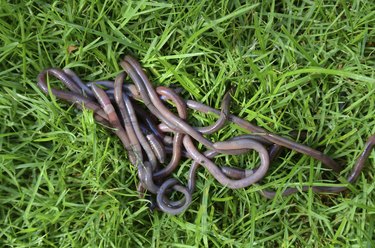
Earthworms help prevent soil from compacting and thatch from building up in your lawn, but their castings can ruin a smooth, uniform surface. Another drawback is that worm-eating moles are attracted to wormy lawns. If your lawn has mounds of worm castings, you can roll them or rake them down. Your options for getting rid of earthworms are limited.
Chemical Suppression
Video of the Day
No pesticides are registered specifically for use against earthworms. Environmental Protection Agency registration of pesticides is intended to ensure the safety of the user and to protect specific natural environments, not to protect individual species. Insecticides containing the active ingredient carbaryl, commercially available to the home gardener, are registered for use to kill white grubs on turf. EPA-approved carbaryl applications necessary to control white grubs on turf will reduce the earthworms in your lawn for one growing season.
Video of the Day
Carbaryl Application
Use a backpack sprayer to apply 6 fluid ounces of carbaryl per 1,000 square feet of lawn in March through May or July through early September. Flush your backpack sprayer to clean the tank before adding the insecticide. Fill the tank with one-third to half of the amount of water you think you will need to cover your lawn, then add the insecticide. Agitate the tank continuously as you spray. Do not spray on a windy day. When you're finished, water your lawn well.
Safety Precautions
Carbaryl is toxic. Wear shoes, socks, long pants, a long-sleeved shirt and chemical- resistant headgear when you apply it. Do not inhale it or get it on your skin or in your eyes. Overexposure can cause blurred vision, diarrhea, muscle cramps, nausea, respiratory failure and unconsciousness in severe cases. If you suspect that you have been poisoned, see a physician and show him the product label.
Tea Seed Pellets
In an autumn test, researchers for the U.S. Golf Association applied pellets of tea seed meal at the rate 6 pounds per 1,000 square feet on putting greens, quickly followed by irrigation. The pellets were roughly 1/8 inch wide and from 1/5 to 1/3 inch long. The application quickly expelled 200 worms per 10 square feet. A similar application in early April reduced worm castings on a putting green by 95 percent for a five-week period and 98 percent for two days and 83 percent over the next month. Natural triterpene saponin toxins in the tea seed were responsible for the result. Organic fertilizers for turf are now on the market that contain tea seed meal as part of the mix.
- University of Wisconsin Cooperative Extension: Earthworms in Lawn
- North Carolina State University Cooperative Extension: Earthworms as Pests in Home lawns
- The Ohio State University: Earthworms
- Purdue University Extension: Moles in Lawn
- University of Missouri Extension: Soil Testing for Lawns
- U.S. Golfing Association: Controlling Earthworm Casts on Golf Courses
- Golf Course Management: The Worm Turns: Earthworm Cast Reduction on Golf Courses
- Carbaryl Insecticide: Specimen Label
- EPA Pesticide Labeling Questions & Answers - Exception to Use in a Manner Not Permitted